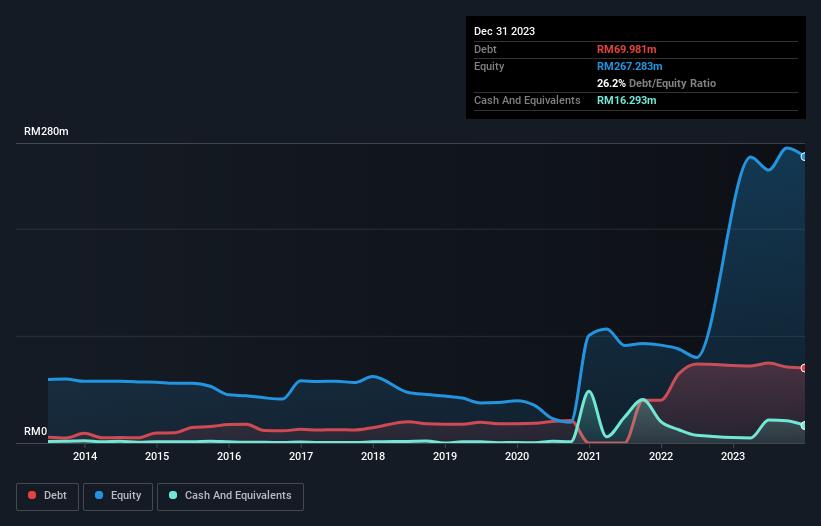Stock Analysis
- Malaysia
- /
- Medical Equipment
- /
- KLSE:ONEGLOVE
Is One Glove Group Berhad (KLSE:ONEGLOVE) Using Debt In A Risky Way?

Some say volatility, rather than debt, is the best way to think about risk as an investor, but Warren Buffett famously said that 'Volatility is far from synonymous with risk.' So it might be obvious that you need to consider debt, when you think about how risky any given stock is, because too much debt can sink a company. As with many other companies One Glove Group Berhad (KLSE:ONEGLOVE) makes use of debt. But the real question is whether this debt is making the company risky.
When Is Debt A Problem?
Debt assists a business until the business has trouble paying it off, either with new capital or with free cash flow. Part and parcel of capitalism is the process of 'creative destruction' where failed businesses are mercilessly liquidated by their bankers. However, a more usual (but still expensive) situation is where a company must dilute shareholders at a cheap share price simply to get debt under control. Of course, plenty of companies use debt to fund growth, without any negative consequences. The first step when considering a company's debt levels is to consider its cash and debt together.
See our latest analysis for One Glove Group Berhad
What Is One Glove Group Berhad's Net Debt?
As you can see below, One Glove Group Berhad had RM70.0m of debt, at December 2023, which is about the same as the year before. You can click the chart for greater detail. On the flip side, it has RM16.3m in cash leading to net debt of about RM53.7m.

How Strong Is One Glove Group Berhad's Balance Sheet?
Zooming in on the latest balance sheet data, we can see that One Glove Group Berhad had liabilities of RM26.9m due within 12 months and liabilities of RM298.3m due beyond that. Offsetting this, it had RM16.3m in cash and RM5.97m in receivables that were due within 12 months. So its liabilities outweigh the sum of its cash and (near-term) receivables by RM303.0m.
This deficit casts a shadow over the RM129.5m company, like a colossus towering over mere mortals. So we'd watch its balance sheet closely, without a doubt. At the end of the day, One Glove Group Berhad would probably need a major re-capitalization if its creditors were to demand repayment. There's no doubt that we learn most about debt from the balance sheet. But it is One Glove Group Berhad's earnings that will influence how the balance sheet holds up in the future. So if you're keen to discover more about its earnings, it might be worth checking out this graph of its long term earnings trend.
In the last year One Glove Group Berhad wasn't profitable at an EBIT level, but managed to grow its revenue by 36%, to RM24m. Shareholders probably have their fingers crossed that it can grow its way to profits.
Caveat Emptor
Despite the top line growth, One Glove Group Berhad still had an earnings before interest and tax (EBIT) loss over the last year. Indeed, it lost a very considerable RM63m at the EBIT level. Considering that alongside the liabilities mentioned above make us nervous about the company. We'd want to see some strong near-term improvements before getting too interested in the stock. It's fair to say the loss of RM72m didn't encourage us either; we'd like to see a profit. In the meantime, we consider the stock to be risky. The balance sheet is clearly the area to focus on when you are analysing debt. But ultimately, every company can contain risks that exist outside of the balance sheet. For instance, we've identified 5 warning signs for One Glove Group Berhad (2 don't sit too well with us) you should be aware of.
Of course, if you're the type of investor who prefers buying stocks without the burden of debt, then don't hesitate to discover our exclusive list of net cash growth stocks, today.
Valuation is complex, but we're helping make it simple.
Find out whether One Glove Group Berhad is potentially over or undervalued by checking out our comprehensive analysis, which includes fair value estimates, risks and warnings, dividends, insider transactions and financial health.
View the Free AnalysisHave feedback on this article? Concerned about the content? Get in touch with us directly. Alternatively, email editorial-team (at) simplywallst.com.
This article by Simply Wall St is general in nature. We provide commentary based on historical data and analyst forecasts only using an unbiased methodology and our articles are not intended to be financial advice. It does not constitute a recommendation to buy or sell any stock, and does not take account of your objectives, or your financial situation. We aim to bring you long-term focused analysis driven by fundamental data. Note that our analysis may not factor in the latest price-sensitive company announcements or qualitative material. Simply Wall St has no position in any stocks mentioned.
About KLSE:ONEGLOVE
One Glove Group Berhad
One Glove Group Berhad, an investment holding company, manufactures, markets, and sells examination gloves and other related activities in Malaysia, Japan, Germany, Singapore, the United States, India, and internationally.
Mediocre balance sheet with weak fundamentals.

